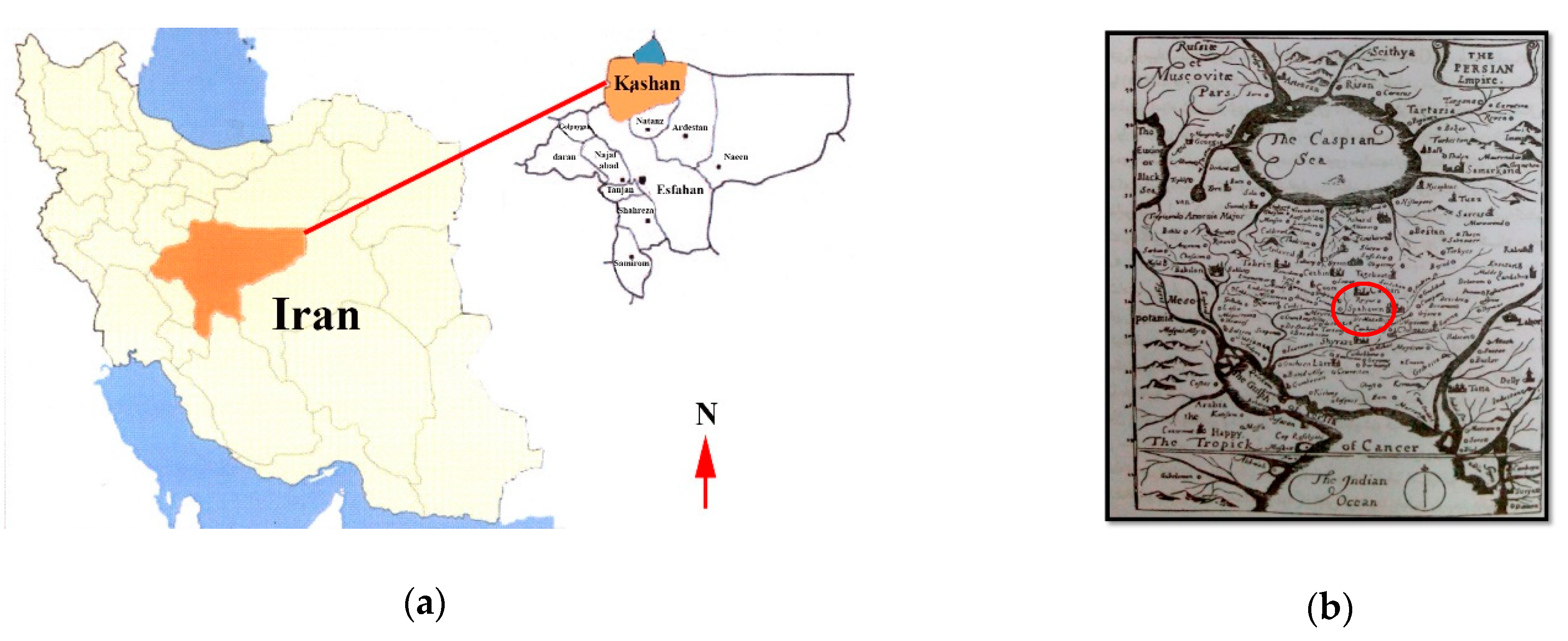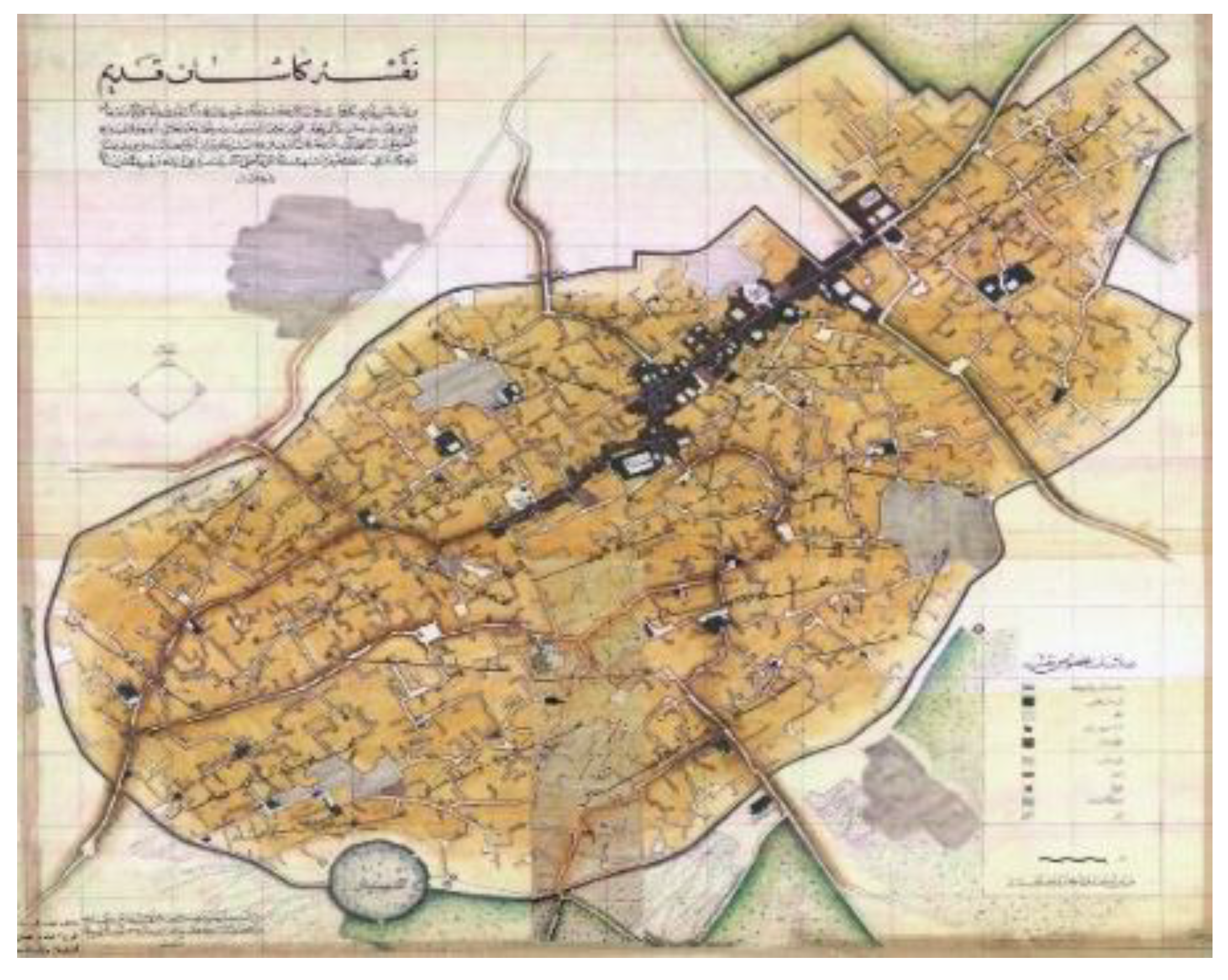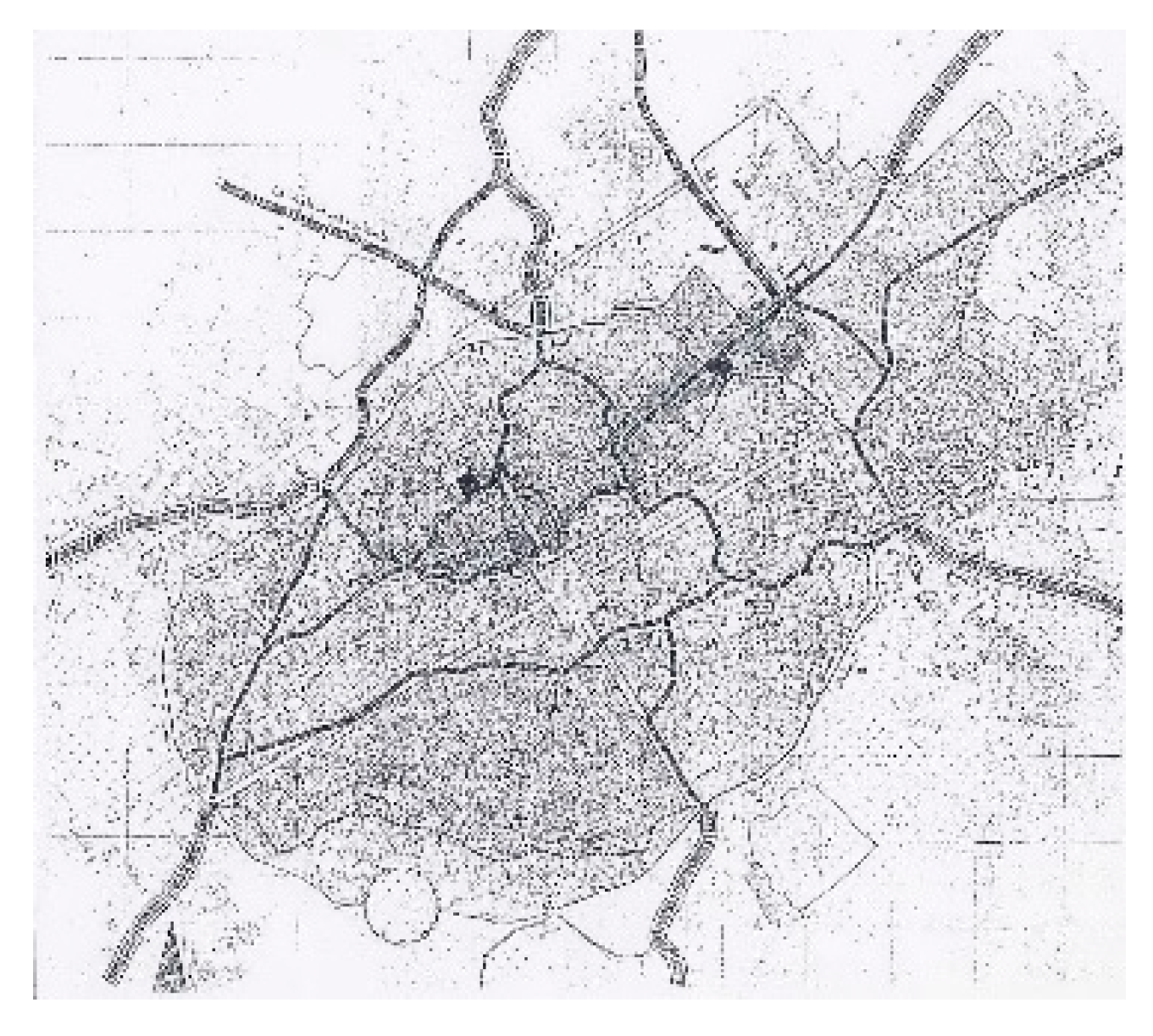Recognizing the Values of Kashan Historic Urban Context for Achieving Appropriate Regeneration (Case Study: Sarpelleh Passageway)
Abstract
:1. Introduction
2. The Regeneration Concept
3. Recognizing Kashan Historic City
4. Materials and Methods
5. Theories and Valuation History (Existing Literature in the World and Iran)
6. Values in Regeneration Schemes
7. Analysis of Detailed Plans in the Neighborhood
- -
- Introducing traffic and pollution into the context, beyond the capacity of the neighborhood;
- -
- Changing the edges to commercial units and gradually destroying spaces in the street edges and their backspaces;
- -
- The passage crosses the center of the historic neighborhood, destroying the identity of this space;
- -
- Demolition of many historically valuable houses and gateways on the path to be widened;
- -
- Destruction of visual and physical cohesion of the context.
8. Examining Existing Values in the Context of Sarpelleh Neighborhood
9. Categorizing Values
10. Results
10.1. Important Design Goals Are Defined as Follows
10.1.1. Historical and Social Values
- Educating the residents,
- Improving the local government and local service offices,
- Providing welfare services to residents and visitors,
- Developing and promoting the role of the center of the neighborhood on a local and regional scale; as a destination for shopping, employment, culture, spending leisure time, and tourism,
- Allocating neighborhood public spaces as spaces for leisure.
10.1.2. Environmental Values
- Developing the public spaces according to people’s demand,
- Improving access to the neighborhood center,
- Developing and improving urban infrastructure as well as providing the required urban services.
10.1.3. Economic Values
- Developing shopping intentions,
- Developing real estate and commercial units,
- Creating job opportunities,
- Connecting the center of the neighborhood and historic Bazaar in the northern side.
10.2. Regeneration Policies Based on the Values
10.2.1. Historical and Social Dimension
- Maintaining and reviving traditional residents’ relations,
- Investing in portions of context to accommodate small households,
- Collaborating and engaging people in the implementation of the programs,
- Strengthening the elements and sets of social services in the context and preventing creation of similar buildings.
10.2.2. Environmental Dimension
- Providing conditional access into the fabric,
- Prioritizing pedestrian access within the context,
- Paying attention to the rehabilitation and restoration of valuable buildings and the necessity of noting the form, materials, empty space, and the dimensions of suitable spaces and passages to the climatic conditions.
10.2.3. Economic Dimension
- Maintaining and reviving traditional productions in the neighborhood,
- Creating retail attractions in the context of texture and pushing major activities to the periphery of the street,
- Restoring and regenerating commercial units.
10.3. Proposed Planning
- -
- The critical idea for the detailed plan of the city dealt with the widening of the middle passageway of the neighborhood (this historical passageway has been connecting the north street to the south). The other critical idea was about the commercial functions defined without considering the historical identity of the central part of the neighborhood. This option, therefore, suggests for the return to the previous status.
- -
- This alternative has a critical perspective of widening the historical passageway and has purposed a walkway axis without widening the streets.
- -
- The widening plan of the historical passageway results in the destruction of a large number of houses on the margin of this passageway, while facilitating access, better services, economic development, and rising land value in the context. Therefore, the proposed plan is accepted if the passageway is paved, so that unnecessary traffic, noise pollution, and disturbing pedestrians’ and cyclists’ comfort is prevented. Furthermore, paving the passageway offers value-based design patterns in the destructed edges, which prevents historical identity destruction and visual disturbance in the facades.
10.4. Schedules
- -
- Reusing existing buildings adaptively during short term,
- -
- Providing criteria and patterns of intervention in the context,
- -
- Revitalizing commercial units to provide handmade arts,
- -
- Making passways more legible by lighting, flooring, and signing.
- -
- Designing and constructing parking lots for residents and clients,
- -
- Revitalization of dyeing and knitting workshops in the context,
- -
- Establishing and strengthening the local governance institutions and community service offices.
- -
- Creating short- and long-term training courses as well as professional, creative, and efficient training in the field of traditional arts in the region,
- -
- Developing the public spaces,
- -
- Maintaining and restoring native residents.
11. Conclusions
Author Contributions
Funding
Conflicts of Interest
References
- Habibi, M.; Maghsudi, M. Urban Restoration, 1st ed.; Tehran University Press: Tehran, Iran, 2003; pp. 131–150. (In Persian) [Google Scholar]
- Lotfi, S. Urban Rebirth, from Reconstruction to Regeneration, 1st ed.; Azarakhsh Publishing House: Tehran, Iran, 2012. (In Persian) [Google Scholar]
- Aieni, M. Regeneration of old urban fabrics, challenges, opportunities, and suggesting appropriate intervention strategies using SWOT techniques. In Proceedings of the International Conference on Architectural and Urban Engineering: Housing Development Policy in Iran, Ministry of Housing and Urban Development, Department of Housing and Building Affairs, Office of Planning and Economics, Tehran, Iran, 10 October 2007; Volume 1, p. 407. (In Persian). [Google Scholar]
- Hajipour, K. An introduction to the evolution and development of urban renewal approaches (post-World War I to the beginning of the third millennium). Andishe Iranshahr 2008, 9–10, 18. (In Persian) [Google Scholar]
- Porahmad, A.; Kalantari, H.; Khalil, H. Planning Techniques and Historical Context of Cities Restoration and Planning Experiences, 1st ed.; Publishing Organization of Jahad University: Ahvaz, Iran, 2007; p. 75. (In Persian) [Google Scholar]
- Habibi, M.; Maghsudi, M. Urban Restoration, 3rd ed.; Tehran University Press: Tehran, Iran, 2007; p. 5. (In Persian) [Google Scholar]
- Ayini, M.; Ardestani, Z. The Pyramid of Regeneration and People’s Participation: Urban Development Planning Evaluation. Urban Identity J. 2008, 5, 47. (In Persian) [Google Scholar]
- Asadi, S.; Naderi, H. Recognizing Historical Contexts Theories. In Recognizing historical context of Kashan; College of Fine Arts, Architecture and Urbanism Faculty, University of Tehran: Tehran, Iran, 2009; p. 2. [Google Scholar]
- Mahmoud Kelaye, S. Preservation and Revitalization Theories. In Preservation and Revitalization of Jameh Mosque of Kashan; College of Fine Arts, Architecture and Urbanism Faculty, University of Tehran: Tehran, Iran, 2009; p. 2. [Google Scholar]
- Naraghi, H. Social History of Kashan; Scientific and Cultural Press of Tehran: Tehran, Iran, 1966. [Google Scholar]
- Shooshtari, I. Persian Dictionary in Arabic; Publication of Association of National Monuments 58; Bahman Printing: Tehran, Iran, 1969; p. 557. [Google Scholar]
- Project of Recognizing Historical Contexts Theories. In Recognizing historical context of Kashan; College of Fine Arts, Architecture and Urbanism Faculty, University of Tehran: Tehran, Iran, 2009; p. 23.
- Aerial photos of the city of Kashan; Documentation of Iran National Cartographic Center (NCC): Tehran, Iran, 1956.
- Olearius, A. Travelogue of Adam Olearius: Safavid Persia from a German Traveler’s Perspective; Ebtekare No Pub.: Tehran, Iran, 2006; pp. 165–166. [Google Scholar]
- Birshak, S. Development and Evolution of the City of Kashan from the Beginning to the End of the Seljuk Period. In Proceedings of the Congress of Iranian Architecture and Urban Planning, Kerman, Iran, 1996; Volume 3, p. 391. [Google Scholar]
- Chardin Travelogue; Tous Publication: Tehran, Iran, 1993; pp. 533–539.
- Atefi, H.; Golkar, A. Kashan’s Ups and Downs according to Others; Publication of Bonyad Farhang Kashan: Tehran, Iran, 2012; p. 499. [Google Scholar]
- Ancient City of Kashan. Available online: http://kashan.today/wpcontent/uploads/2017/05/Kashan-rooftop1-800×438.jpg (accessed on 6 January 2019).
- Crispendorf, C. Content Analysis, Methodology Basics; Naibi, H., Ed.; Nashre Ney: Tehran, Iran, 2008. [Google Scholar]
- Worthing, D.; Bond, S. Managing Built Heritage; Wiley-Blackwell: Hoboken, NJ, USA, 2008; p. 60. [Google Scholar]
- Falamaki, M. From word to text to recognition of urban Revitalization in Iran. Abadi J. 2005, 45, 26–28. (In Persian) [Google Scholar]
- Kostof, S. The City Shaped; Thames and Hudson: London, UK, 1991. [Google Scholar]
- Lefebvre, H. The Production of Sdpace; Donald, N.-S., Ed.; Blackwell: Oxford, UK, 1991. [Google Scholar]
- Susser, I. Cities and Social Theory; Blackwell: Oxford, UK, 2002; p. 392. [Google Scholar]
- Attoe, W.; Logan, D. American Urban Architecture: Catalysts in the Design of Cities; University of Colombia Press: New York, NY, USA, 1989. [Google Scholar]
- Carmona, M.; Latham, I.; Swenarton, M.; Chatwin, J. The Value of Urban Design; A Research Project Commissioned by CABE and DETR to Examine the Value Added by Good Urban Design; CABE: London, UK, 2001. [Google Scholar]







| Row | Individuals/ Organizations Charters | Date | Values |
|---|---|---|---|
| 1 | Alice Riegl | 1902 | Modern values (relative artistic/novelty/artistic/practical), commemorative values (favorite commemorative/historic/old) (Riegl, 1996) |
| 2 | Feilden & Jukilehto | 1993 | Cultural values, identity, relative artistic or technical value, rare value, social and economic value, functional, educational, political |
| 3 | Randall Mason | 2002 | Social–cultural values (historic value/cultural–symbolic value/social value/spiritual–religious value/aesthetic value), economical values (functional value/nonfunctional value/existence value/optional value/heritage value) |
| 4 | English Heritage | 1997 | Cultural value, aesthetic value, innovation value, authenticity, economical value, educational value |
| 5 | Frey | 1997 | Monetary, option, existence, bequest, prestige, educational |
| 6 | Burra Charter | 1998 | Aesthetic, historic, scientific, social (including spiritual, political, national, other cultural) |
| 7 | Feilden | 2003 | Emotional value, cultural value, practical values |
| 8 | David Throsby | 2006 | Aesthetic, spiritual, social, historical, symbolic, authenticity |
| 9 | Mehdi Hodjat | 2001 | Emotional values (aesthetic, symbolic, spiritual, and wonder values), historic values (cultural continuity, identity, oldness, unique values/urban environment, and architectural values), scientific values (ecological values, documentary values, archeological values) |
| 10 | Mohammad Reza Rahimzadeh | 2009 | Historic value Cultural value Day value |
| Value | Type | Qualitative Attributes (Values) | Quantitative Attributes (Values) |
|---|---|---|---|
| 1- Historical and social values | Historical | Vicinity of the neighborhood with the historical route | About 83 valuable monuments, occupying about 40% of the neighborhood area |
| Emotional | Remaining valuable spaces in the context | Spatial relationships and the hierarchy of tracks and old access | |
| Religious | The rich history of the religious ceremonies such as “Ashura” | Sarpelleh mosque in the neighborhood center | |
| Identity | The existence of the main, neighbors’ relations, the continuation of traditions, social relations, and collective memories | 40% of inhabitants are native residents (source: oral interviews) | |
| Authenticity | Despite the destruction of the earthquake and war, the primary materials are used. | 10 historic building with authenticity, 36 historic building without authenticity | |
| Scientific/Educational | The abilities of old skillful workmen in knitting professions which makes an educational opportunity for trainees | 10 valuable buildings with scientific and educational values | |
| Social | Habitation of one of the great poets of Kashan in 1955–1956 | 2 dyeing workshops (abandoned) and traditional knitting workshops (two active workshops) | |
| 2- Environmental and physical values | Architectural | Valuable historic monuments | 10 valuable historic buildings (national significance), 83 non-registered historical buildings such as Rashadi, Sahib, Zarkar’s houses |
| Environmental | Environmentally-friendly design | Appropriate orientation, door proportions, passages height and openings in adaptation to climate | |
| Location | Quality of buildings placement in the context, relationship between mass and space | 40% of the whole buildings are adapted with the historic context | |
| 3- Economic values | Functional | Existence of Manouchehri cultural and tourism complex | Commercial units adjacent to Mohtasham and Abazar streets |
| Non-functional | Kashan Textiles as source for attracting a businessman and investor | Increase of property price due to function of Manouchehri complex |
| Type | Value |
|---|---|
| Functional, non-functional | Economic value |
| Architectural, coordination, proximity and combination of spaces, aesthetics, environmental, skill/technical, innovation/achievement, rarely, documental, authenticity | Environmental and physical value |
| Historical, scientific/educational, political, social, religious, authenticity, identity, emotional | Historical and social value |
© 2019 by the authors. Licensee MDPI, Basel, Switzerland. This article is an open access article distributed under the terms and conditions of the Creative Commons Attribution (CC BY) license (http://creativecommons.org/licenses/by/4.0/).
Share and Cite
Rezazadeh Ardebili, M.; Rezazadeh Ardebili, R.; Moradi, M. Recognizing the Values of Kashan Historic Urban Context for Achieving Appropriate Regeneration (Case Study: Sarpelleh Passageway). Heritage 2019, 2, 1390-1403. https://doi.org/10.3390/heritage2020088
Rezazadeh Ardebili M, Rezazadeh Ardebili R, Moradi M. Recognizing the Values of Kashan Historic Urban Context for Achieving Appropriate Regeneration (Case Study: Sarpelleh Passageway). Heritage. 2019; 2(2):1390-1403. https://doi.org/10.3390/heritage2020088
Chicago/Turabian StyleRezazadeh Ardebili, Mojtaba, Romina Rezazadeh Ardebili, and Mojgan Moradi. 2019. "Recognizing the Values of Kashan Historic Urban Context for Achieving Appropriate Regeneration (Case Study: Sarpelleh Passageway)" Heritage 2, no. 2: 1390-1403. https://doi.org/10.3390/heritage2020088
APA StyleRezazadeh Ardebili, M., Rezazadeh Ardebili, R., & Moradi, M. (2019). Recognizing the Values of Kashan Historic Urban Context for Achieving Appropriate Regeneration (Case Study: Sarpelleh Passageway). Heritage, 2(2), 1390-1403. https://doi.org/10.3390/heritage2020088




